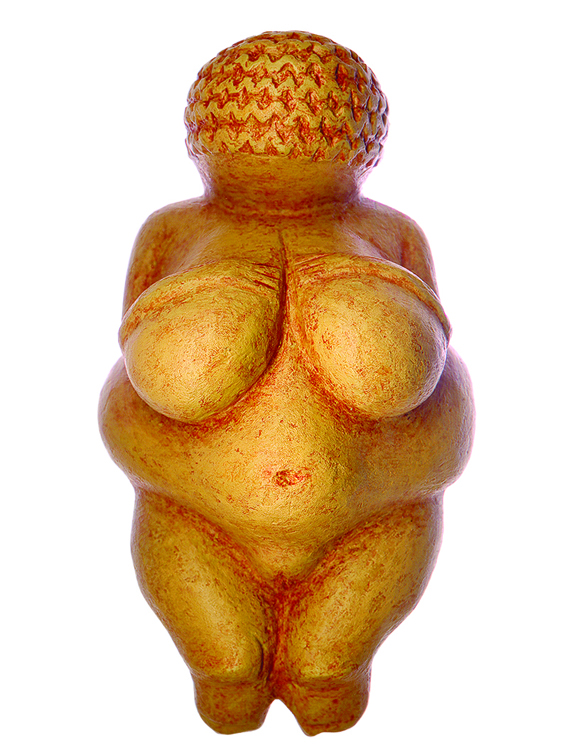In the story of human origins, the so-called „Big Bang“ of human culture that took place some 40,000 years ago, was a watershed moment when hitherto unremarkable anatomically modern humans who had been around for some 160,000 years, suddenly started to make art, use language and make sophisticated tools that were the results of chains of operations that combined different materials. The resulting culture is known as the Aurignacian, named after Aurignac in France, where the first of these new artifacts were identified. During the Ice Age, the River Danube never ceased to flow and the Aurignacians arrived in Europe by following the course of the river upstream. Moving North into the Wachau, the they will have found that the valley was a corridor of milder climate that sandwiched between the ice-encrusted mountains of the Alps and the Bohemian Massive. In the sheltered valleys on the south-facing northern banks, small trees grew. Sheltered from the wind and catching the sun whenever it shone, over the millennia, groups repeatedly returned to camp on the northern slopes. Austria’s most famous artefact from the Aurignacian, is the slender figurine known as „Fanny“. This was found in 1988, on the slopes of a hill just outside Krems where, during the Middle Ages criminals were hung. Today an Ice Age Walk leads through the vineyards and woods of the gently undulating landscape with display boards providing insights into the nature of the lives lead by Aurignacian hunter-gathers.

The find consisted of eight fragments of slate which when pieced together, revealed an image of a woman in a semi-dynamic pose. As the figure’s stance was reminiscent of a pose adopted by the Nineteenth Century ballet dancer, Fanny Elßler, the sculpture was named „Fanny“ and is one of the earliest indications of a modern human presence in the region.
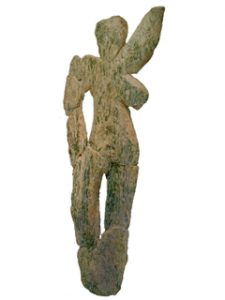
While the original is in the Natural History Museum in Vienna, a copy is on display in Museum Krems. Although simplistically rendered, a high degree of skill and co-ordination will have been necessary in order to carve the figure without breaking the stone. While the figure’s upper arm is raised upwards, the lower arm is turned back towards the body in such a way that the hand is trapped between the raised left shoulder and the neck. Contrasting sharply with this uncomfortable posture, the right arm is directed downwards with the hand resting or pressing on a stick which is in contact with the ground. Where the left leg is straight, the right leg is slightly bent so that the hips are inclined, sinking down towards the right. The figure is female, with the left breast shown in profile and a vulva that is disproportionately detailed when compared with the cursory way in which the rest of the body has been depicted. While this latter feature accords with imagery from the period found in caves in France and the Ukraine, the dynamic pose and slender features are in tune with a Central European style in which there is an emphasis on movement and a focus on that which is graceful, with flying and an addressing of things that are in the air being clearly discernible themes. Movement is a noticeable characteristic of a series of sculptures found at the Vogelherd Cave in Germany and to which the word „exquisite“ can be readily applied.

Near the Vogelherd Cave there is the Hohlenstein-Stadel Cave where the so-called „Lion Man of Lonetal“ was found. This depicts what is generally accepted as a man with a lion’s head.

The body is tensed with the hands clenched while feet are shown as if the subject were not standing on the ground. This suggests that the figure is a shaman engaged in a journey to another world. Another figure found at the Geissenklösterle Cave in the same region, is the „Worshipper“ who also has otherworldly connotations.
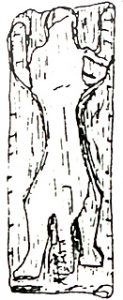
The frozen and yet inherent dynamism of the Lion Man of Lonetal puts into context the dynamic qualities of the animals of the Vogelherd Cave. During an altered states experience, after passing through a tunnel or a door a subject crosses over into the other world and typically either talks with animals, rides on their backs or even becomes one. In shamanism, flying, either on the back of an animal, or through visible or invisible wings of one’s own are common place experiences, as is the feeling of being catapulted up into the air by a mysterious power. One may thus suggest that the Lion Man represents a shaman flying through the air, while the Worshipper represents someone endeavouring to make contact with the other world. In shamanism, the world behind our world is seen and the subject learns that after death, this is where all beings end up before being re-born again. Typically a subject either flies through the sky or goes down into an underworld. Often a protective spirit is often encountered who takes the form of an animal who may be talked or who has a message. As an all enveloping and complex hallucination, shamanic experiences are subject to cultural conditioning and in encoded form, subjects encounter their own day to day problems, aspects of their unconscious as well as cultural concerns of a more general nature. Among the concerns of Aurignacian hunters will have feelings of guilt about the killing of the animals hunted, particularly animals such as mammoth, deer and bison whose eyes are the same size as human eyes making it difficult not to feel empathy with them. Although cooking will have provided a way of transforming raw meat into something tasty that carpeted over feelings of guilt, in journeying to the world behind our world, one can suggest that it was the shaman’s task to effect a longer lasting form of absolution for what had been done. This is dramatically confirmed in a manner that can only be described as „utterly baffling“. Repeatedly it has been shown that if a group subjects enter a shamanic trance whilst adopting the Fanny pose, on the content level, what they experience not only has a common structure but also their experiences echo the concerns outlined above. Taken together these experiences indicate a vision of the world in which it is acknowledged that human activities can cause disturbances in a cosmic web or pattern. Combined with ethnological evidence in which such scenarios are repeated in the language of myth, this gives compelling support to the thesis that the structure of the human nervous system is such that the adoption of the Fanny posture by a subject whilst in shamanic trance state does structure what is experienced in exactly the same way that it did 40.000 years ago. Although this conclusion was arrived at scientifically, the implications and questions raised are for most archaeologists not only confusing but also lead to areas that are seen as being too close to the esoteric and what is seen as an unscientific approach. Accordingly in archaeology, this take on the matter is largely ignored. However among those convinced and as one who is not afraid of voicing her opinion, is Christine Neugebauer-Maresch, the archaeologist who conducted the excavation during which Fanny was found.
After a period of some 10,000 years, the Aurignacian began to give way to a culture known as the Gravette, which was maintained for some seven thousand years. This was again an Upper Palaeolithic culture of hunter-gatherers who lived semi-nomadic lives. Although life was short and hard, the culture was resilient and was capable of withstanding less than favourable conditions. Thus despite the fact that during this time, temperatures were colder than during the Aurignacian, Gravettian culture spread from the South of France and Spain up into the farthest reaches of Siberia. For people of the Gravette, the desire for contact was a major driving force, with different groups of people no longer living in ignorant isolation of each other but instead being anxious to establish and maintain contact with other groups. For the first time, exotic materials such as amber and shells were traded and transported over long distances. These were used as ornaments and denoted status. Gravettian culture is known for its so-called „Venus figurines“, with the world-famous Venus of Willendorf being the most well-known example. This was found in Willendorf, some 20 Kilometres upstream from Krems. Carved from limestone, the figurine was found on a sunny day in August, 1908.
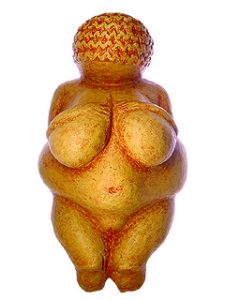
The figurine was found during excavations that were carried out prior to the building of the Krems-Grein railway. The most appropriate way of getting to Willendorf is thus to travel by train along the Wachau Bahn, either from Krems in the East, or from Melk in the West. To get to the site known as Willendorf II, one simply walks East along the road that runs on the South side of the railway. After a few minutes, a sign indicates that one should turn left and walk up the road before turning right. Here a path and steps lead up to a small garden where an enlarged statue marks the place where the 29,000 year-old figurine first saw the light of day. Where the original lies behind high-security glass in the Museum of Natural History in Vienna, the place where she was found in Willendorf is marked by an enlarged version of the figure rendered in artificial stone.
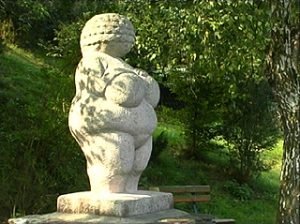
Research shows that the stone out of which the figurine was made did not come from Austria but most likely either came from Sega di Ala, near Lake Garda in the North of Italy or from the Ukraine. Where the geological samples favor Italy, art-historical considerations favor the Ukraine. Along with the shells and amber, this shows how during the Gravette, a vast cultural network extended over the whole of Europe. Forming a series of variations on a theme, Venus figurines were an indication of solidarity with a common cultural system. The purpose of this system was the maintaining relations between groups so that enabled marriage partners to be exchanged and the problem of incest avoided. Communication over longer distances will have slow and haphazard with meetings being infrequent and celebrated as big events. Wherever she came from, the Venus of Willendorf’s journey is likely to have taken not weeks and months but years and generations. In the village of Willendorf, a small museum gives a brief introduction to life during the Upper Palaeolithic.
Regardless of how the Venus of Willendorf is seen and with what she is associated, anyone seeing the figure in the round, must concede that the forms have been moulded with a care and delicacy, that would have made any baroque artist proud. The feet, whilst dissolving away at the ankles into nothing, do not appear to be absent from the composition. Rather they have been hinted at and that is enough. Likewise, the absent features of the blank face are not missing as such but rather are as if the artist has decided to show the face as a blank mirror so as to ask or say something about womanhood and the human condition. The detailed rendition of what is generally assumed to be hair makes it clear that from a technical point of view, the artist could have shown facial features had he or she wanted to. Indeed everything about the composition of the Willendorf figure and its execution indicates that this was a highly sophisticated piece, made by someone with a clear idea of what they wanted to convey and a clear conception of how, in formal terms, this was to be done. A masterfully succinct diagram by André Leori-Gourhan shows how nearly all of the 160-odd known Venus figurines follow a common compositional scheme.
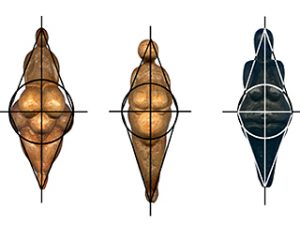
Though many are crude and artistically uninteresting, there are several that are not only very different from the Venus of Willendorf but are also equally innovative.
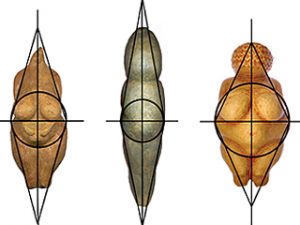
Characterised by slightly sunken heads and blank, featureless faces, the arms of Venus figurines usually either rest on the breasts or supporting them from underneath. The breast, hips and stomach region form the centrepiece of the composition and the figures depicted are often pregnant. The feet are either small and diminuated or like the Venus of Willendorf have omitted all together. Depicting various bodily types, the figurines show varying stages of pregnancy as well as girls and women who are not pregnant. Among the figurines that are depicted as being pregnant, there are first-time mothers and those who have been mothers several times. Though the figurines lack faces, they do seem to represent real people and are an indication that during the Gravette female nakedness was used as a vehicle to express individuality. This will have not only involved an individual’s allure and appeal to the other sex but will have also constituted an attempt at understanding the wider cycles and rhythms that the female body is subjected to during life. Seen this way, they are attempts made by individuals to understand and orientate themselves not only from one month to another and so from season to season but also within the wider time frameworks of life. The well-nourished state of the Venus of Willendorf implies knowledge of the fact that under-nourishment in women results in the cessation of the menstrual cycle and an end to fertility, with this being seen as undesirable. That this was a concern during the upper Palaeolithic is shown by an examination of skeletons from the period, in which it was found that under-nourishment was not uncommon. In addition, while twelve percent of skeletons belonged to males over forty, there was not a single skeleton of a woman who had reached the age of thirty. From this it can be assumed that death as a result of childbirth will have been common. All this suggests that Gravettian Venus figurines are most parsimoniously explained as having been made „by women for women“.

Knowledge that a common unit of time governed both the rhythms of the female body and the phases of the moon is implied by a crudely anthropomorphic Gravettian figure from the Pavlov Hills in the Czech Republic, which has been engraved with twenty-eight notches enclosed by two series of parallel lines. An example of a Gravettian moon calendar, is given by an engraved pebble from the Epi-Gravettian strata of Barma Grande in the Grimaldi region of northern Italy. This features sequences that backtrack on themselves, resulting in complicated patterns of „V“s, „X“s, zigzag lines and cross-hatching effects.

The majority of sequences were found to consist of between 29 and 31 notches and would thus appear to document the passing of a month. Shorter sequences appeared to record periods of a week, ten days or a fortnight. Added together, these groups again gave totals of between 28 and 31. Though two short sequences were left over, combined with two longer sequences on the edge of the stone, they yielded totals of 58 and 62, corresponding to periods of two months. The sequences of notches on the stone thus appeared to be a document of the passing of 15 months, with an average of just over 29 days for each month. This suggests that an engraved mammoth ivory rod found at Willendorf in the same level as the Venus and carefully engraved with a sequence of tailed notches reminiscent of „1’s“ may also be a moon calendar. 20.5 centimetres long, like the Venus of Willendorf, it may be seen in the Natural History Museum Vienna and if the interpretation that it is a moon calendar is correct, it records the passing of one full month and the beginning of a second, with the full month being comprised of four divisions.
![]()
The fragments of a relief found at Lausell in France give clear indications that nakedness, the rhythmically cycles of the moon and femininity were combined in rituals that in all likelihood will have excluded men.
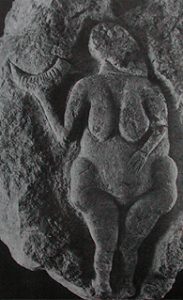
This is further confirmed by the fact that many Venus figurines have been found in storage pits, indicating period, ritual use as opposed to continual use. One can thus suggest that Gravettian Venus figurines and the rituals associated with them will have part of an endeavor to understand and put into context, the processes of puberty, menstruation, pregnancy, birth and child-rearing. Each of the figurines is individual and yet the blank faces seem to address something that is shared and collective. By abstracting the facial features, the hopes and fears of the women are transferred and focused towards something higher that goes beyond the power not only of any single woman but of also of the assembled group as an whole. The figurines can thus be seen as addressing the supra-human, expressing life and femininity in terms of a principle of which each individual woman was a part of. Where the abstract faces reach out towards the higher principle of womanhood that transcends any individual woman, the personalised bodies summon these powers for the benefit of the individual depicted. Just as when making a wish, or praying, we close our eyes, the blank faces are a gesture of humility and sincerity. Seen this way, Gravettian Venus figurines can be considered to have functioned as interfaces that mediated between the self, with its hopes and fears, the demands of society and the higher powers of fate.

After being found, the Venus of Willendorf was taken to the rooms of the village inn where the archaeologists conducting the excavation lived and where, at the end of the day, they wrote up their reports. It was here that the Venus was washed and the masterful execution that characterises the figurine first became apparent. It was also noted that the figurine was adorned with zigzag bracelets on each on arm. This was interpreted as jewellery and on closer examination, it can be seen that a significant number of Gravettian Venus figurines are not actually naked but are in fact shown wearing some form of bodily adornment or lingerie as exemplified by an example from Kostienki in Siberia.
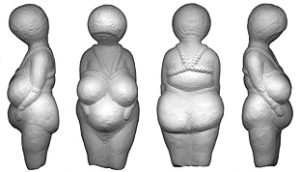
The techniques used suggest that the materials depicted are not leather thongs or tattoos but rather are woven fibres. Aware of the differences in the materials that they were representing, care was taken to use different techniques to represent different woven and plaited materials. Contrasting with the lingerie that is shown as zigzags, is the succession of lozenges that occur on a second Venus from Kostienki. A fired clay fragment from Pavlov, shows a female torso adorned with a belt. Here the belt is shown using a different technique that suggests that what is shown was not woven but rather was plaited or twined. Meanwhile the supposedly naked Venus of Lespunge, is shown wearing a shirt that has been tied back at the back to form a tail, this being a practice that is well documented in ethnology. Archaeologists estimate that in the average culture, the ratio of perishable to durable products produced, is in the order of 20:1 and during the Gravette it can be assumed that this will have also been the case. There is a strong argument that not only are the Venus of Willendorf’s bracelets woven but that her ornate hair-do is in fact a radially woven cap.
At Dolni Vestonice and the other sites in the Pavlov Hills that lie North of the Waldviertel Plateaux, a vast number of fired and unfired clay fragments have been found, including 79 pieces where the clay bears impressions made by fabric and other woven materials. Here indications were found of ten different types of cordage, fifteen different types of woven textile and two types of basket making techniques. In addition, the imprints of a knotted net were also found. In another investigation, the patterns of wear on battens, loom sticks and spindles from recent history were compared with the markings on bone artefacts which have otherwise been assumed to have had a ritual rather than a practical use and in a number of cases the patterns were found to be strikingly similar. Raw materials for weaving are likely to have been milkweed and nettle and pollen analyses from the Pavlov Hills and Siberia have confirmed the presence of both at that time. Also confirmed was the presence of alder and yew trees, whose fibrous barks may also have been used for cordage and basketry. The technical sophistication of the weaving depicted on Gravettian Venus figurines and found imprinted on the clay fragments suggests that weaving and cord-making must have started considerably earlier than the 27,000 BP to which Dolni Vestonice is dated, with the research team giving a date of 40,000 BP as a conservative estimate. During the Gravette, it would seem that women were capable of producing textiles that may have resembled linen, with an imprint from Dolni Vestonice being so fine as to compare favourably with fabrics produced during the Neolithic. The high standard of weaving and cord making suggests that net-making was well advanced, with the trapping smaller and even medium sized mammals possibly making a major contribution to the dietary needs of a group. This is in accordance with the view that during the Upper Palaeolithic women not only gathered roots and berries but also hunted smaller animals, with trapping being a much more communal activity than the hunting of larger animals such as mammoth. Hunting with nets may well explain the low number of long range hunting weapons in eastern Gravettian lithic and bone assemblages and the total lack of spear throwers, which are found elsewhere. Further confirmation is given by the fact that eastern Gravettian assemblages contain plenty of weapons for thrusting at close range and these might have been used for dispatching animals caught in nets. Hunting with nets would enable mass harvests and for the phenomenon of surplus, exemplified by the Venus of Willendorf, to be known. These considerations puts into context the lingerie depicted on Gravettian Venus figurines, concerning which, it is argued that the detailed stitching shown on some of the Venus apparel was deliberately designed to draw attention to the skill and sophistication of women in their role as weavers. This in turn suggests that the importance to the survival of a group of spinning, weaving and cord making was well understood and valued with the ability to make them being a part of female allure and probably betokening status.
The last culture of the Ice Age was that of the Magdalén, which came into being sometime around 18,000 BP and laster to around 12,000 BP. As in the Gravette, people of the Magdalén lead semi-nomadic lifestyles, repeatedly returning at the beginning of each new season to camps they had left the year before. Moon calendars and other Magdalénian artefacts engraved with seasonally focused imagery show that as in the Gravette, time and periodicity were central concerns. During the Magdalén temperatures became warmer and the glaciers of the Ice Age slowly began to recede. This opened up landscapes that had hitherto been closed off from habitation and it was during the Magdalén that the spear-thrower used by modern day hunter-gathers was invented, with the oldest example dating to 18.000 BC. Running hand in hand with this geographical expansion was an extending of social networks, resulting in the naturalistic style of Gravettian Venus figurines being replaced by images that are much more stylised and abstracted.
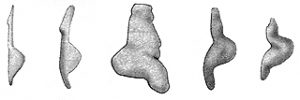
Comparing Gravettian Venus figurines with the newer „Gönnersdorf images“ was what enabled Gaudzinski-Windheuser and Jöris to propose that Gravettian Venus figurines figurines represent real individuals, resulting in a „personified symbol“ which although individual, expresses a common idea that was partaken of by all women. Female nakedness was thus used „as a vehicle to emphasise individuality“ with this being supported by the lingerie shown on many Venus figurines. Gönnersdorf images are by contrast, not personal symbols but rather are group symbols, and the information denoted, though it relates to the „female sphere“ does so in a different way and is indicative of a new mentality. Although sexuality is thematised, individuality and a sense of a communal identity have been added, resulting in a process of abstraction taking place. Gönnersdorf images are typically more „scenic“ and relief’s often show not one women but several. This new sense of „communal identity“, as opposed to the Gravettian notion of participating in a „common idea“, reflects an awareness of the abstraction of femininity to which women had to conform. Where Gravettian Venus figurines were kept in storage pits from which they were extracted for ritual use, Magdalén images were intended to be seen by a wider public. Images engraved on the walls of caves were clearly made to be looked at and some of the mobile figurines have holes in them suggesting that they were worn in some way. Where Gravettian Venus figurines seem to refer to contexts that staged the naked body of an individual woman, images from the Magdalén stage instead, the idea of the female as a general idea, the idea of womanhood as a universal principle. Associated with these changes, it likely that there were changes in the social roles of women and how they were seen during the Late Magdalén.
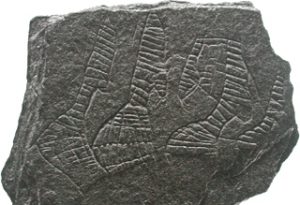
Although the Magdalén is famous for the painted caves of Lascaux and Altamira, the mobile art of the period is of equal artistic quality and consists of thousands of bone and ivory artefacts engraved with images from the natural world in which seasonally focused juxtapositions of birds, flowers, fish, plants and animals are depicted. In Austria, the only known figurative image from the period dates from 14,000 BP and was found in the Gudenus Cave only a little way North of the Wachau.

Engraved on the ulna of an eagle, the piece shows a reindeer’s head together with engraved lines that would appear to stand for some form of count and/or the passing of a temporal process.

Aurignacian Source Material
Cowan, J. D., Ermentrout, G. B., A Theory of Drug induced Visual Hallucination Patterns, in Pattern Formation by dynamic Systems and Pattern Recognition, edited by Haken, H., Springer Series in Synergenetics, Springer Verlag Berlin, Heidlberg, 1979
Goodman, F., Trance, der uralte Weg zum religiösen Erleben, Gütersloher Verlagshaus, Güterloh, 1992
Gore, B., Ecstatic Body Postures, Bear & Co., Santa Fe, 1995
Kühnel, H., and Schönfeldner, F., Tausend Jahre Krems, ein Jubiläumsbuch, including Die Venus von Galgenberg by Neugebauer-Maresch, Jugend & Volk, Vienna, 1995
Lewis-Williams, D. and Clottes, J., Les Chamans de la Préhistoire – Transe et Magie dans les Grouttes ornaées, Editions du Seuil, Paris, 1996/ Schamanen, Trance und Magie in der Höhlenkunst der Steinzeit, Thorbecke Speläothek, Jan Thorbecke Verlag, Sigmaringen, 1997
Lewis-Williams, D., The Mind in the Cave, Thames and Hudson, London, 2002
Markus, M., Halluzinationen: ihre Entstehung in der Hirnrinde kann im Computer simuliert werden, in Welten des Bewustseins, edited by Dietrich, A., Hoffmann, A. and Leuner, H., Verlag für Wissenschaft und Bildung, Berlin, 1994
Siegel, R. K., Fire in the Brain, New American Library, New York, 1992/Hallulluzinationen: Expeditionen in eine andere Wirklichkeit, Rowohl Taschenbuch Verlag GmbH., Reinbek bei Hamburg, 1998
Gravettian Source Material
Angier, N., Fur for Evening, but Cloth was the Stone Age Standby – an interview with Soffer, O., and Adovasio, J. M., in New York Times, December 14, New York, 1999
Cook, J., Ice Age Art – the arrival of the modern mind, British Museum Press, London 2013
Coward, F., Hosfield, R., Pope, M., Wenban-Smith, F. (editors), Settlement, Society and Cognition in Human Evolution – Landscapes in Mind, including Contextualising the Female Image – Symbols for Common Ideas and Communal Identity in Upper Palaeolithic Societies, Gaudzinski-Windheuser, S. and Jöris, O., Cambridge University Press, New York, 2015
Gamble, C., The Palaeolithic Societies of Europe, Cambridge University Press, Cambridge, 1999
Lawson, A. J (editor), Essays in Palaeolithic Art, including The Female Image: a „time-factored“ symbol. A study in style and aspects of image use in the Upper Palaeolithic by Marshack, A., Proceedings of the Prehistoric Society 57/1, The Prehistoric Society London, 1991
Marshack, M., The Roots of Civilisation, Weidenfeld & Nicholson, London, 1972
Soffer, O., Adovasio, J. M., Hyland, D.C., The „Venus“ Figurines –Textiles, Basketry, Gender and Status in the Upper Palaeolithic (with comments by Marshack and others), in Current Anthropology Volume 41, Number 4 (August-October 2000), The University of Chicago Press, Chicago, 2000
Soffer, O., Adovasio, J. M., Hyland, D.C., Klima, B. and Svodoba, J., Perishable Industries from Dolni Vestonice I: New Insights into the Nature and Origin of the Gravettian, in Archaeology and Anthropology of Eurasia, January 2001, Siberian Branch of the Russian Academy of Sciences, Elservier, Amsterdam, 2001
Soffer, O., Recovering Perishable Technologies through Use Wear on Tools: Preliminary Evidence for Upper Palaeolithic Weaving and Net Making, report in Current Anthropology Volume 45, Number 3 (June 2004), The University of Chicago Press, Chicago, 2004


